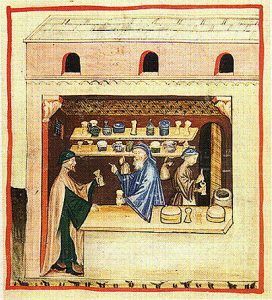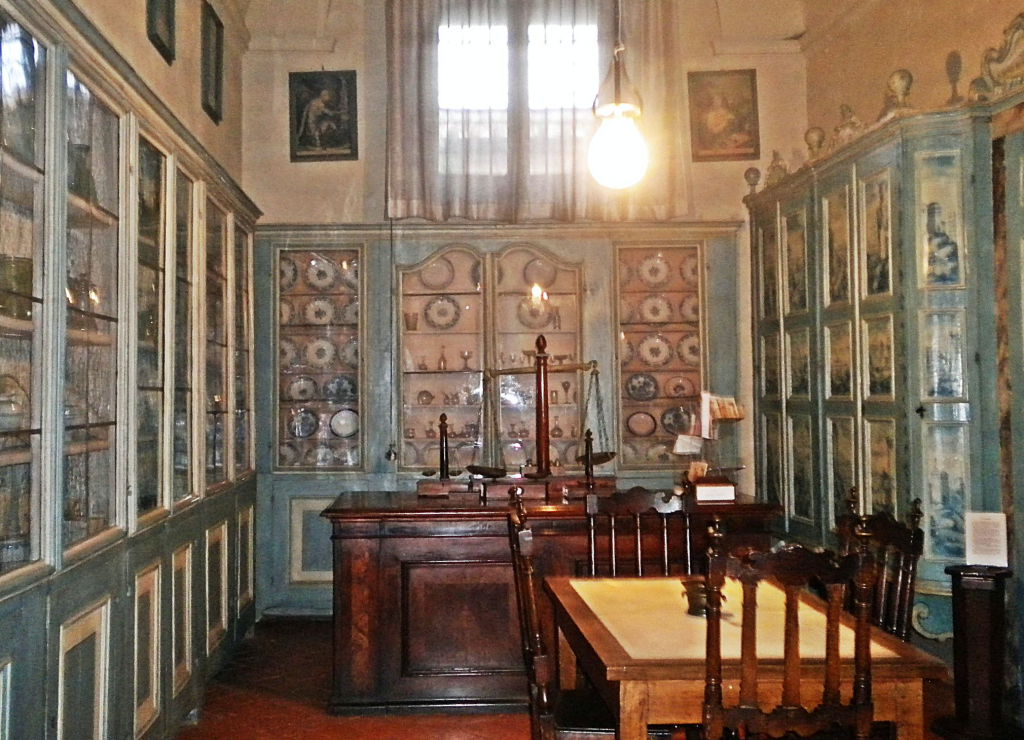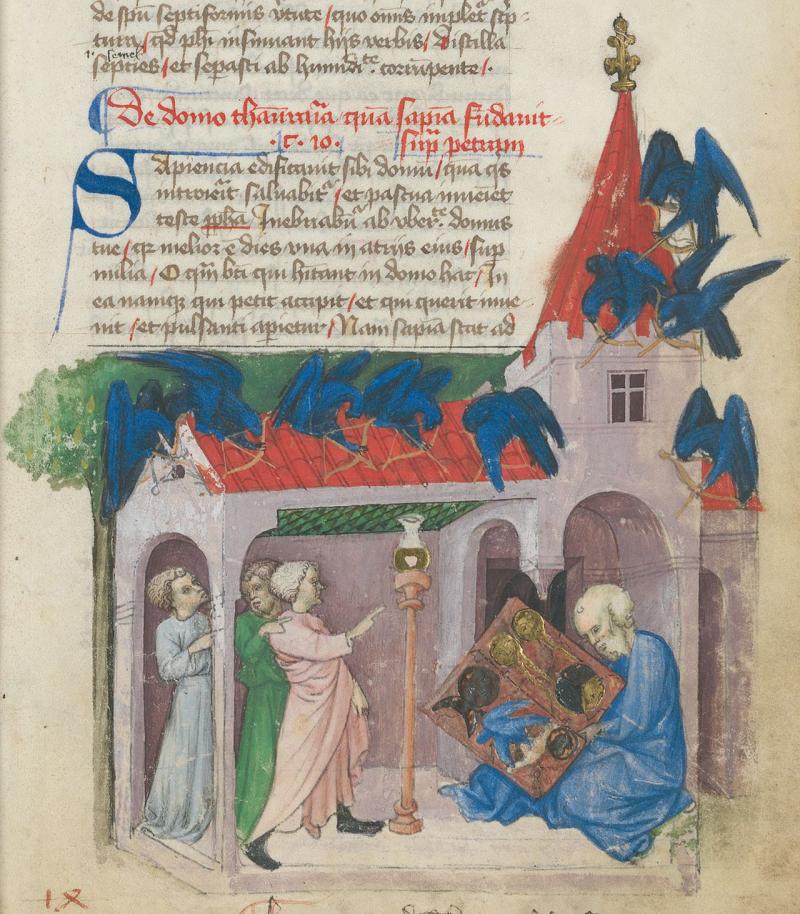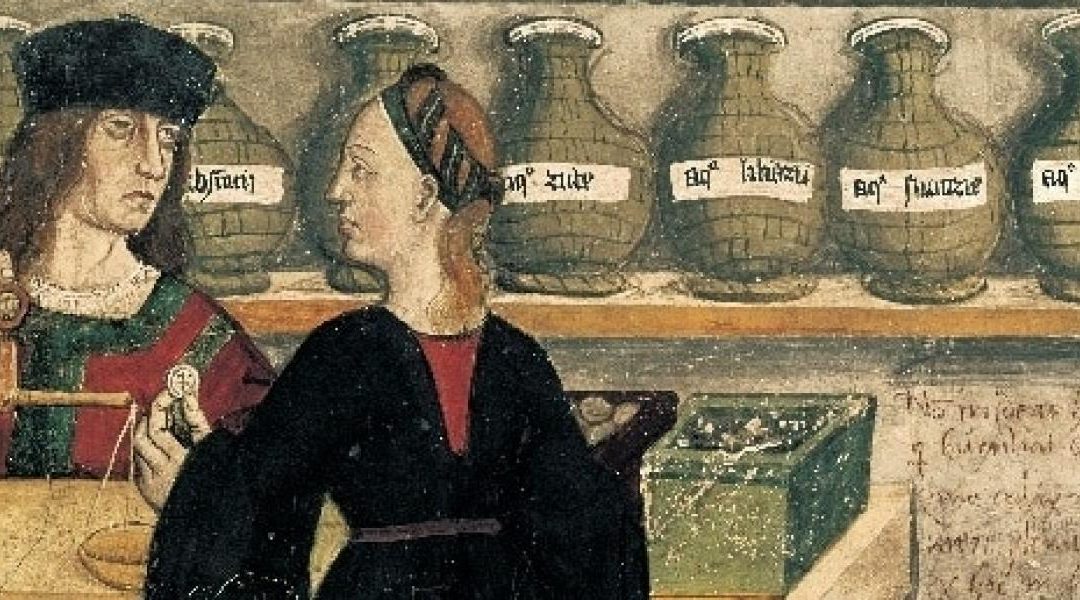—Places where the transformation processes of raw materials for a great number of consumer products were carried out.—

Apothecary Tacuinum sanitatis. Viena, ca. 1400 Points (Alcohol & Drugs History Society).
Apothecaries were a type of basic artisan, well recognised in medieval times. For a variable number of years, they trained in the rudiments of the trade with a master, earning a meagre salary at the end. Indeed, this was the way in which most artisans learned, including those who were dedicated to medicine, such as barber-surgeons and the majority of physicians. Only a small number of medieval physicians were university educated. The apprentice could not leave the master’s home until the end of the contractual period and he undertook to serve his master in all matters that were lawful and honest. The latter was obliged to feed and clothe him. After the agreed period, if he had enough money, the young apothecary could open his own shop. Many, however, became the official employees of other more powerful apothecaries. It was very common for the owner (the master), other apothecaries of a lower category and a changing group of apprentices and slaves to converge in the workshop, depending on the master. Moreover, it was very common for the apothecaries’ wives to work with their husbands and continue the management of the workshop after they became widows.
The skills that apothecaries had to develop to carry out their work were numerous, and there was a wide range of literature from classical and Arab roots that allowed them to make up many of their recipes. This is shown by the instruments found in their workshops: stills (distillation and sublimation were the recommended procedures to obtain the ‘inner virtues’ of the animal, plant and mineral products needed to obtain medicines), scales, cedars, spatulas, jars and objects of very different forms and materials to preserve and transport products, mortars, boilers and other tools; and increasingly rich libraries of medical works, prescriptions and antidotes. Medieval apothecaries were not too different from those of the nineteenth century. In both, the presence of ceramics (pharmacy jars) to preserve the ingredients and prepare the medicines was very abundant and they offered a unique image of different colours and shapes that today make us consider them authentic works of art. We must also bear in mind that monasteries, convents and hospitals were able to have their own apothecary for the service of the resident clergy, as well as for the poor sick and other people who would have to be cared for in those places.

Apothecary of the monastery of San Niccolò (Prato, 14th c.). Wikimedia.
Indeed, one of the most common characteristics among apothecaries was the enormous variety of activities and products they could make. In fact, the making of medicines (potions, oils, pastes, juices, syrups, water, powders, pills) was often not the most important task and there were many homemade remedies made by healers that people often purchased. During the medieval centuries, it was quite common for the apothecary to be synonymous with the spice seller, since along with medicines they offered spices for cooking and much more: dyes (for fabrics and pigments for painters), confectionery, jams, nuts, paper, ink, gunpowder, perfumes and wax objects (for lighting, votive offerings, religious rituals, etc.). The key principle that allowed for all this production was the method of production: the formulation. From a technical point of view, producing medicines was not so different from producing spiced wines, ink or sauces. From simple products, other compounds were obtained by following similar procedures: decoction, decantation, filtration, distillation, preservation in sugar or honey, maceration, dissolution, spraying, etc. Over time, all these occupations became part of the work of different more specialised trades. In the end, it can be seen that for a long time the apothecary was a multifaceted technician whose occupation was only partially the making of medicines. There were also those who ended up practising medicine and surgery thanks to their skills.

Image of an apothecary’s shop showing the variety of products. Fresco of the castle of Isogne (Valle d’Aosta, 15th c.). Focus.
Apothecaries, among many other artisans and also highly educated individuals (including the clergy), became interested in alchemy, a discipline far removed from the esoteric and uninformed image that is often held today. The term comes from the Arabic al-kimiya, which in turn comes from the Greek chymeia. Literally, its meaning was ‘the art of fusion [of metals]’, but its interest was not only confined to the transmutation of metals but also to certain aspects of chemistry and mineral technology in addition to its connection to the production of medicinal remedies. Although the aim was to find a panacea that would cure everything, which remained a chimera, along the way other subtler procedures were found that allowed many other useful products to be obtained. Any medieval alchemy codex gathered instructions for the synthesis and refining of products such as ammonia salt, alkaline salt, alum, tartar salt and pigments such as vermilion, white lead, red lead, etc. They also, on occasion, listed ways of making glues or enamels. Moreover, they explained metal refining processes through sublimation, distillation, dissolution, coagulation, precipitation or crystallisation. Alchemy sought to encompass technological aspects within a theoretical framework. This led to it being seen as a discipline linked to natural philosophy and not a mere mechanical art.
Although alchemy had its origins in Greek Hellenism, it was actually barely known in the Latin world. Not so the Arab legacy, which would be partly translated and incorporated into Christian Europe. Between the ninth and the tenth century, the Arabs composed a large number of original treatises on alchemy. The highly speculative works of Jābir ibn Hayyān, translated by Gerard of Cremona (Liber de septuaginta) are an example. Rāzī also arrived translated, with a much more technical component, and later, the third prominent author was the Persian physician Avicenna. It was during the thirteenth century that a serious attempt was made to comprehend the important volume of Arab works on alchemy. In this regard, it is worth noting the great interest shown by clerics such as Albert the Great (c. 1200-1280) or Roger Bacon (c. 1219-1292), which shows the favourable reception of these texts by scholasticism. However, the most widely known work was the Summa Perfectionis by Geber. He was followed by others such as the Occitan Franciscan Jean de Roquetaillade (De consideratione quintæ essentiæ), written towards the middle of the fourteenth century in the midst of a tense religious controversy about the acceptance or condemnation and prohibition of the practice of alchemy. However, in the end, it spread significantly among the different sectors of society interested in it.

An alchemical treatise from the 15th century. Aurora Consurgens, Zürich Zentralbibliothek de Zurich, Ms. Rh. 172 (Saint Gall, 15th century). Wikipedia.
Recent studies have highlighted the experimental component of many alchemical texts, which cannot be understood without reference to a complex variety of products, operations and instruments. Alchemy had a strong and changing relationship with other intellectual and religious currents, which also introduced new ideas, practices and objectives, from the transformation of metals into gold to spiritual purification, the prolongation of life or, in a much more practical and circumspect sense, the obtaining of materials of technological interest or therapeutic products through techniques such as distillation or sublimation. As also happened with other intellectual currents during the late Middle Ages, one of the characteristics of the period was a greater interaction between alchemy and religious debate within the various currents of Christian theology. There was also a greater connection between alchemy and medicine and pharmacy, which favoured both the use of new products discovered in alchemical laboratories (for example, the whole new range of distillates with what we now call ‘alcohol’), as well as new uses or different preparations of products used in medicine for centuries (for example, compounds of lead, copper, arsenic, salts, etc.).
Carmel Ferragud
IILP-UV
How to cite this paper:
Ferragud, Carmel. The apothecary and the alchemist’s workshop. Sabers en acció, 2020-11-23. https://sabersenaccio.iec.cat/en/the-apothecary-and-the-alchemists-workshop/.
Find out more
You can find further information with the bibliography and available resources.
Recommended reading
García Ballester, Luis; López Piñero, José Mª; Peset, José Luis, coords. Historia de la ciencia y de la técnica en la Corona de Castilla, vols. 1-2 (Edad Media). Valladolid: Junta de Castilla y León; 2002, p. 865-914.
Studies
Alexandre-Bidon, Danièle. Dans l’atelier de l’apothicaire : histoire et archéologie des pots de pharmacie : XIIIe-XVIe siècle. París: Picard; 2013.
Bénézet, Jean-Pierre. Pharmacie et médicament en Méditerranée occidentale (XIIIe -XVIe siècles). París: Honoré Champion; 1999.
Cifuentes, Lluís. La ciència en català a l’Edat Mitjana i el Renaixement. Barcelona-Palma de Mallorda: Universitat de Barcelona-Universitat de les Illes Balears; 2006. 2 ed.
De Vun, Leah. Prophecy, alchemy, and the End of Time: John of Rupescissa in the Late Middle Ages. Nova York: Columbia University Press; 2014.
Ferragud, Carmel; Bertomeu, José Ramón. Mirades sobre l’alquímia a la València baixmedieval: un procés judicial sobre la producció de l’or potable (1440-1445). 2015. Afers; 82: 421-446.
García Ballester, Luis. La búsqueda de la salud. Sanadores y enfermos en la España medieval. Barcelona: Península; 2001.
Joly, Bernard. Histoire de l’alchimie. París: Vuibert-Adapt; 2013.
Newman, William R. Medieval Alchemy. En: Lindberg, David C.; Shank, Michael H., dirs. The Cambridge history of Science. Vol. 2: Medieval Science. Cambridge: Cambridge University Press; 2015, p. 548-568.
Pereira, Michela. Per una història de l’alquímia a la Catalunya medieval. En: Joan Vernet; Ramon Parés, dirs. La Ciència en la història dels Països Catalans. Dels àrabs al Renaixement, Valencia: Institut d’Estudis Catalans-Universitat de València; 2004, p. 455-482 .
Pereira, Michela. Cap als orígens de l’alquímia medieval: presència d’alquimistes i desenvolupament de les doctrines de l’alquímia a les Illes Balears (segles XIII-XV). In: Història de la ciència a les Illes Balears. Vol. I: L’Edat Mitjana. Govern de les Illes Balears: Conselleria d’Economia, Hisenda i Innovació, Palma; 2006, p. 153-169.
Vela, Carles. L’obrador d’un apotecari medieval segons el llibre de comptes de Francesc ses Canes (Barcelona, 1378-1381). Barcelona: CSIC; 2003.
Websites and other resources
Cifuentes i Comamala, Lluís, dir. Sciència.cat DB Base de datos de la ciencia y la técnica en catalán en la Edad Media y el Renacimiento [actualizada en 2020; consulta 20 de junio de 2020]. Available here.
Concòrdia i patrimoni. Tresors de la farmàcia catalana. Commemoració del 5è centenari de l’edició del llibre de la Concòrdia dels apotecaris de Barcelona, 1511-2011 [Catálogo de exposición] [consulta 25 de junio de 2020]. Available here.
Figuerola i Pujol, coord. Pharmakoteka. Base de dades de medicaments antics [consulta 25 de junio de 2020]. Available here.
Museu da Farmácia. Lisboa. [actualizada en 2015; consulta 25 de junio de 2020]. Available here.
Reial Monestir de Santa Maria de Pedralbes. Plantes, remeis i apotecaris. El jardí medieval del monestir de Pedralbes [Exposición] [actualizada el 20 de junio de 2020; consulta 25 de junio de 2020]. Available here.
UNESCO. Memoria del mundo. Manuscritos medievales de medicina y farmacia [actualizada en 2917; consulta 25 de junio de 2020]. Available here.



